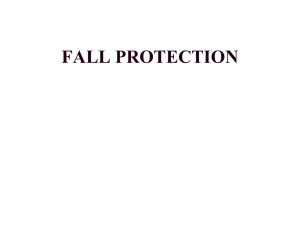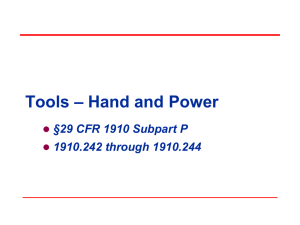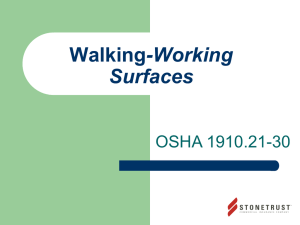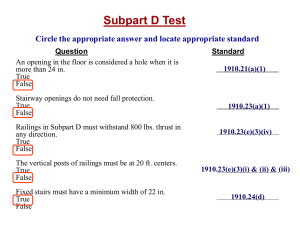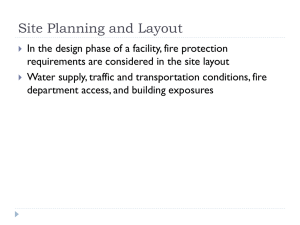Walking-Working Surfaces
advertisement
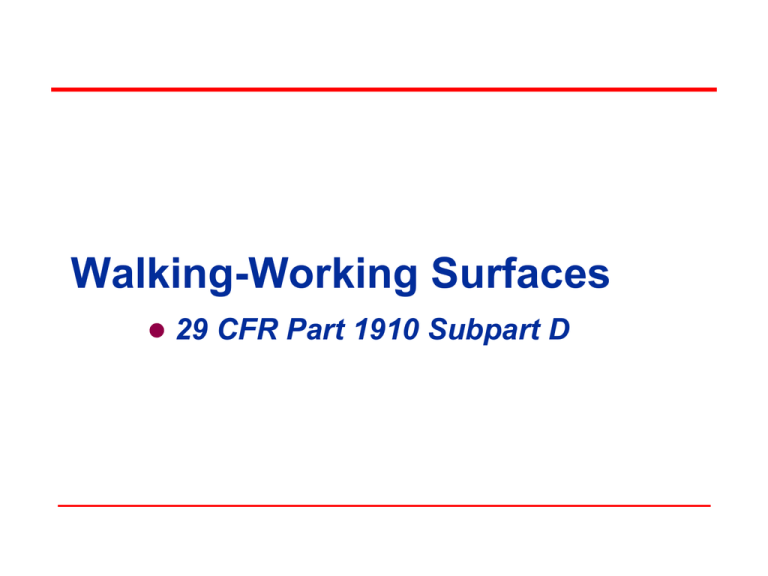
Walking-Working Surfaces 29 CFR Part 1910 Subpart D Objectives In this course, we will discuss the following: Hazards Definitions General requirements Guarding floor and wall openings and holes Ladders Scaffolds Other working surfaces Hazards Slips, trips and falls Falls constitute the majority of general industry accidents and contribute to the majority of construction accidents. Definitions §1910.21(a)(1) Floor hole An opening measuring less than 12 inches but more than 1 inch in its least dimension, in any floor, platform, pavement, or yard, through which materials but not persons may fall. » Such as a belt hole, pipe opening, or slot opening Definitions §1910.21(a)(2) Floor opening An opening measuring 12 inches or more in its least dimension, in any floor, platform, pavement, or yard through which persons may fall. » Such as a hatchway, stair or ladder opening, pit, or large manhole » Floor openings occupied by elevators, dumb waiters, conveyors, machinery, or containers are excluded from this subpart. Definitions §1910.21(a)(10) Wall hole An opening less than 30 inches but more than 1 inch high, of unrestricted width, in any wall or partition. » Such as a ventilation hole or drainage scupper Definitions §1910.21(a)(11) Wall opening An opening at least 30 inches high and 18 inches wide, in any wall or partition, through which persons may fall. » Such as an opening for a window, yard-arm doorway or chute opening Is this a floor hole or opening? General Requirements §1910.22(a) Housekeeping Workplaces shall be kept clean, orderly, and sanitary. Workroom floors shall be maintained as clean and dry as possible. Every floor, working place and passageway shall be kept free from protruding nails, splinters, holes, or loose boards. General Requirements §1910.22(b) Aisles and passageways Aisles and passageways shall be kept clear and in good repair. Permanent aisles and passageways shall be marked. Where mechanical handling equipment is used, aisles, loading docks, and doorways shall maintain sufficient safe clearances. General Requirements Covers and guardrails Shall be provided to protect workers from the hazards of open pits, tanks, vats, ditches, etc. §1910.22(c) General Requirements §1910.22(d) Floor loading protection Load ratings shall be marked on plates of approved design and be conspicuously posted. Unlawful to place a load rating limit greater than approved by building official. Floor Openings §1910.23(a)(1) Stairway floor opening Shall be guarded by a standard railing Railing shall be provided on all exposed sides (except at entrance to stairway) Floor Openings §1910.23(a)(2) Ladderway floor opening or platform Guarded by a standard railing with standard toeboard on all exposed sides (except at entrance to opening). Passage through the railing either provided with a swinging gate or so offset that a person cannot walk directly into the opening. Floor Openings §1910.23(a)(3) Hatchway and chute floor opening Guarded by hinged floor opening cover equipped with standard railings or permanently attached Floor Openings §1910.23(a)(4) Skylight floor opening and hole Shall be guarded by a standard skylight screen or a fixed standard railing on all exposed sides Floor Openings §1910.23(a)(5) Pit and trapdoor floor opening Infrequently used openings shall be guarded by a floor opening cover of standard strength and construction. While the cover is not in place, the pit or trap opening shall be constantly attended by someone or shall be protected on all exposed sides by removable standard railings. Floor Openings §1910.23(a)(6) Manhole floor opening Shall be guarded by a standard manhole cover which need not be hinged in place While the cover is not in place, the manhole opening shall be constantly attended by someone or shall be protected by removable standard railings. Floor Openings §1910.23(a)(7) Temporary floor opening Shall have standard railings, or shall be constantly attended by someone Floor Openings §1910.23(a)(8) Every floor hole into which persons can accidentally walk shall be guarded by either: A standard railing with standard toeboard on all exposed sides, or A floor hole cover of standard strength and construction » While the cover is not in place, the floor hole shall be constantly attended by someone or shall be protected by a removable standard railing. Wall Openings and Holes Every wall opening from which there is a drop of more than 4 feet shall be guarded by: Rail, roller, picket fence, half door, or equivalent barrier Where exposure below to falling materials, a removable toe board or the equivalent shall also be provided. §1910.23(b) Open-Sided Floors and Platforms §1910.23(c) Open-sided floors or platforms 4 feet or more above adjacent floor or ground level shall be guarded by a standard railing (or equivalent) on all open sides, except where there is an entrance to a ramp, stairway, or fixed ladder. Open-Sided Floors and Platforms §1910.23(c)(1) Railing shall be provided with a toeboard wherever, beneath the open sides: Persons can pass There is moving machinery There is equipment with which falling materials could create a hazard Open-Sided Floors and Platforms §1910.23(c)(2) Runways Shall be guarded by a standard railing on all open sides 4 feet or more above floor or ground level Wherever tools, machine parts, or materials are likely to be used on the runway, a toeboard shall also be provided on each exposed side. Open-Sided Floors and Platforms §1910.23(c)(3) Regardless of height, a standard railing and toeboard must be used to guard: Open-sided floors, Walkways, Platforms, or Runways … located above or adjacent to dangerous equipment, pickling or galvanizing tanks, degreasing units, and similar hazards. Open-Sided Floors and Platforms Is this correct? Stairway, Railings and Guards §1910.23(d)(1) Every flights of stairs with four or more risers shall have standard stair railings or handrails. On stairways less than 44 inches wide having both sides enclosed, at least one handrail, preferably on the right side descending. Stairway, Railings and Guards §1910.23(d)(1) On stairways less than 44 inches wide having one side open, at least one stair railing on open side. On stairways less than 44 inches wide having both sides open, one stair railing on each side. Stairway, Railings and Guards §1910.23(d)(1) On stairways >44 inches wide <88 inches wide, one handrail on each enclosed side and one stair railing on each open side. On stairways 88 or more inches wide, one handrail on each enclosed side, one stair railing on each open side, and one intermediate stair railing located approximately midway of the width. Railings, Toeboards and Covers §1910.23(e) Standard railings Consist of top rail, intermediate rail, and posts, and have a vertical height of 42 inches from upper surface of top rail to floor, platform, runway, or ramp level. The intermediate rail shall be approximately halfway between the top rail and the floor, platform, runway, or ramp. Railings, Toeboards and Covers §1910.23(e) Handrails Height shall be not more than 34 inches nor less than 30 inches from upper surface of handrail to surface of tread in line with face of riser or to surface of ramp A strength to withstand at least the minimum requirement of 200 pounds top rail pressure Railings, Toeboards and Covers §1910.23(e) Toeboards Shall be 4 inches nominal in vertical height from its top edge to the level of the floor, platform, runway, or ramp Railings, Toeboards and Covers §1910.23(e) Skylight screens Shall be capable of withstanding a load of at least 200 pounds Wall opening barriers Shall be capable of withstanding a load of at least 200 pounds Fixed Industrial Stairs Stair strength Shall be able to carry 5 times expected load; minimum of 1,000 pounds Stair width Minimum width of 22 inches §1910.24 Fixed Industrial Stairs Treads Shall be slip resistant with uniform rise height and tread width §1910.24 Fixed Industrial Stairs §1910.24 Angle of stairway rise Fixed stairs shall be installed at angles to the horizontal of between 30 degrees and 50 degrees Table D-1 gives rise/tread dimensions which will produce a stairway within the permissible range Fixed Industrial Stairs §1910.24 Vertical clearance A minimum clearance of 7 feet above any stair tread to an overhead obstruction Portable Ladders §1910.25 and 1910.26 Stepladders - three types Type I - Industrial stepladder » 3 to 20 feet for heavy duty use, such as utilities, contractors, and industrial use Type II - Commercial stepladder » 3 to 12 feet for medium duty use, such as painters, offices, and light industrial use Type III - Household stepladder » 3 to 6 feet for light duty, such as light household use Portable Ladders §1910.25 and 1910.26 Straight and extension ladders Length of single ladders or individual sections of ladders shall not exceed 30 feet Two-section ladders shall not exceed 60 feet in length Trestle ladders/Platform ladders Shall be not more than 20 feet in length Portable Ladders §1910.25 and 1910.26 Use and care Be maintained in good condition at all times Not be used for anything other than intended use Shall be inspected frequently » If defects are found, mark and take out of service Designed as a one-man working ladder based on a 200-pound load (cont’d) Portable Ladders Base placed a distance from the vertical wall equal to one-fourth the working length of the ladder Must be placed with secure footing Shall be placed as to prevent slipping, or it shall be lashed, or held in position (cont’d) §1910.25 and 1910.26 Portable Ladders §1910.25 and 1910.26 When used to gain access to a roof or other area, shall extend at least 3 feet above the point of support Tops of stepladders shall not be used as steps Ladders shall not be placed on boxes, barrels, or other unstable bases Must be placed with the two rails supported Portable Ladders Portable metal ladders 1910.333(c)(7) » Portable ladders shall have non-conductive side rails if they are used where the employee or the ladder could contact exposed energized parts. §1910.26(c)(3)(viii) Fixed Ladders Cages or wells required if longer than 20 feet to a maximum unbroken length of 30 feet Platform with standard railings and toeboard required every 30 feet (if no safety device provided, every 20 feet) Cages shall extend down the ladder to a point not less than 7 feet nor more than 8 feet from base Cages shall extend a minimum of 42 inches above the top of landing §1910.27 Fixed Ladders §1910.27 Ladder safety devices may be used on tower, water tank and chimney ladders over 20 feet in unbroken length instead of cage protection No landing platform required Preferred pitch of fixed ladders shall be considered to come in the range of 75 degrees and 90 degrees with the horizontal Permanently attached to a structure, building or equipment Fixed Ladders §1910.27 Shall be inspected regularly, with the intervals between inspections being determined by use and exposure Metal ladders and appurtenances shall be painted or otherwise treated to resist corrosion and rusting Wood ladders, when used under conditions where decay may occur, shall be treated with a nonirritating preservative Scaffold Types Frame or Fabricated Pole Scaffold Specialty Scaffold Types Ladder Jack Mobile Pump Jack Tube and Coupler Scaffold Types Float Multipoint Adjustable Two-Point Swing Scaffolding §1910.28 General requirements for all scaffolds Shall not be altered or moved horizontally while in use or occupied Overhead protection shall be provided for men on a scaffold exposed to overhead hazards (cont’d) Scaffolding §1910.28 Footing shall be sound, rigid, and capable of carrying the maximum intended load Shall be capable of supporting at least four times the maximum intended load Planking shall be scaffold grade (cont’d) Scaffolding §1910.28 Shall be secured to permanent structures Screen mesh shall be provided between the toeboard and the guardrail where persons are required to work or pass under the scaffolds. Must be plumb, level, and squared. (cont’d) Scaffolding §1910.28 All planking or platforms shall be overlapped (minimum 12 inches) or secured from movement. An access ladder or equivalent safe access shall be provided. Scaffold planks shall extend over their end supports not less than 6 inches nor more than 18 inches. Employees shall not work on scaffolds during storms or high winds. Scaffolding §1910.28 General requirements for wood pole scaffolds Cross bracing shall be provided between the inner and outer sets of poles Where planking is lapped, each plank shall lap its end supports at least 12 inches Guardrails with a mid-rail, and toeboards, shall be installed at all open sides on all scaffolds more than 10 feet above the ground or floor » Toeboards shall be a minimum of 4 inches in height Scaffolding Example of point loading §1910.28 Scaffolding §1910.28 1910.28(c) Tube and coupler 1910.28(d) Tubular welded frame 1910.28(e) Outrigger 1910.28(f) Masons’ adjustable multiple-point suspension 1910.28(g) Two-point suspension (swinging) 1910.28(h) Stone setters’ adjustable multiple-point suspension 1910.28(i) Single-point adjustable suspension 1910.28(j) Boatswain’s chair 1910.28(k) Carpenters’ bracket (cont’d) Scaffolding 1910.28(l) §1910.28 Bricklayers’ square 1910.28(m) Horse 1910.28(n) Needle beam 1910.28(o) Plasterers’, decorators’, and large area 1910.28(p) Interior hung 1910.28(q) Ladder-jack 1910.28(r) Window-jack 1910.28(s) Roofing brackets 1910.28(t) Crawling board or chicken ladders 1910.28(u) Float or ship Mobile Ladder Stands and Scaffolds §1910.29 Mobile Ladder Stands and Scaffolds §1910.29 Work platforms and scaffolds shall be capable of carrying the design load. Design working load of ladder stands shall be calculated on the basis of one or more 200-pound persons together with 50 pounds of equipment each. All ladder stands and scaffolds shall be capable of supporting at least four times the design working load. Mobile Ladder Stands and Scaffolds §1910.29 Design load of all scaffolds Light - Designed and constructed to carry a working load of 25 pounds per square foot. Medium - Designed and constructed to carry a working load of 50 pounds per square foot. Heavy - Designed and constructed to carry a working load of 75 pounds per square foot. Mobile Ladder Stands and Scaffolds §1910.29 Work levels Maximum work level height shall not exceed four times the minimum or least base dimensions of any mobile ladder stand or scaffold Minimum platform width for any work level shall not be less than 20 inches for mobile scaffolds (towers). Ladder stands shall have a minimum step width of 16 inches (cont’d) Mobile Ladder Stands and Scaffolds §1910.29 Scaffold work levels 10 feet or higher above the ground or floor shall have a standard guardrail, midrail, and toeboard A climbing ladder or stairway shall be provided for proper access and egress Mobile Ladder Stands and Scaffolds §1910.29 Wheels or casters Shall be properly designed for strength and dimensions to support four times the design working load. Scaffolds casters shall be provided with a positive wheel and/or swivel lock to prevent movement. Ladder stands shall have at least two of the four casters and shall be of the swivel type. Mobile Ladder Stands and Scaffolds 1910.29(b) §1910.29 Mobile tubular welded frame scaffolds 1910.29(c) Mobile tubular welded sectional folding scaffolds 1910.29(d) Mobile tube and coupler scaffolds 1910.29(e) Mobile work platforms 1910.29(f) Mobile ladder stands Other Working Surfaces §1910.30 Dockboards (bridge plates) Portable and powered dockboards shall be strong enough to carry the load imposed on them. Portable dockboards shall be secured in position, either by being anchored or equipped with devices which will prevent their slipping. Handholds, or other effective means, shall be provided on portable dockboards to permit safe handling. Other Working Surfaces §1910.30 Forging machine area Enough clearance between machines to allow unobstructed operator movement Aisles shall be sufficient width to permit free movement of employees bringing and removing material Other Working Surfaces §1910.30 Veneer machinery Sides of steam vats shall extend to a height of not less than 36 inches above the floor, working platform, or ground. Large steam vats shall be provided walkways between sections. » Walkway shall be provided with a standard handrail on each exposed side Workmen shall not ride or step on logs in steam vats Summary In this course, we discussed: Hazards Definitions General requirements Guarding floor and wall openings and holes Ladders Scaffolds Other working surfaces Thank You For Attending! Final Questions? Handouts Place all handouts at the end of this presentation.
